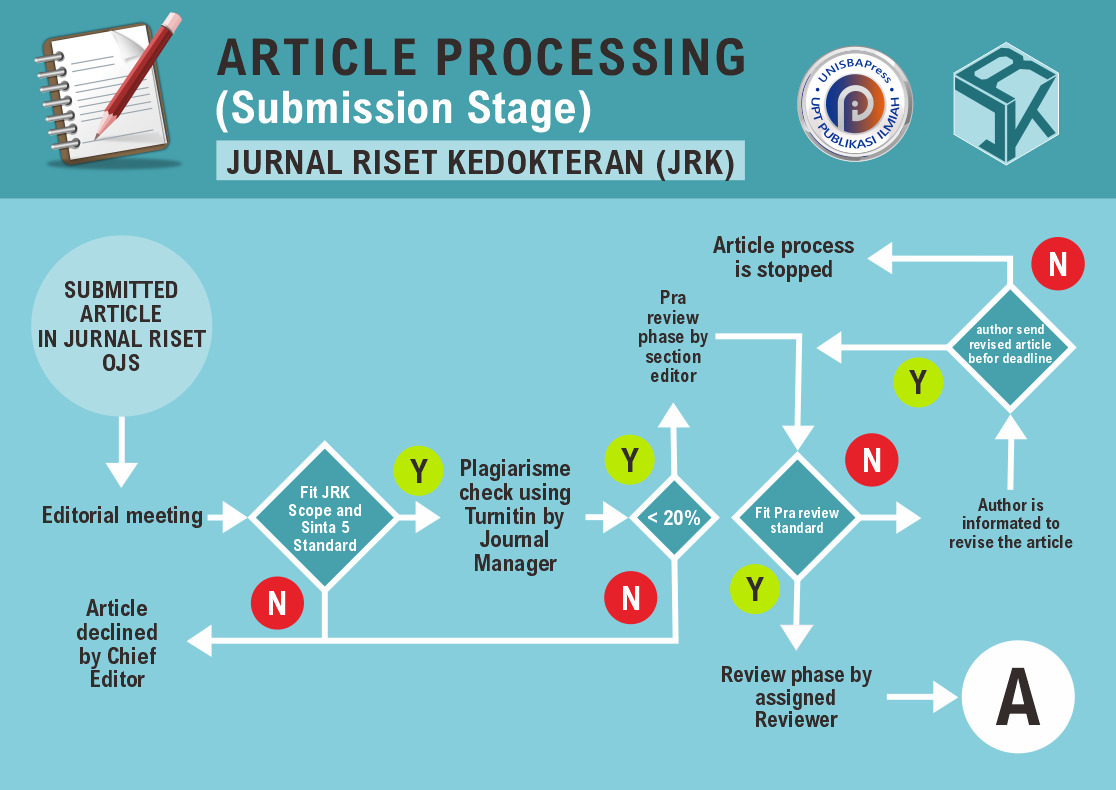Pap Smear sebagai Metode Deteksi Dini Kanker Serviks
DOI:
https://doi.org/10.29313/jrk.vi.1775Keywords:
Pap Smear, Deteksi Dini, Kanker ServiksAbstract
Abstract. Cervical cancer has the third highest mortality rate in the world from all cancer cases. This figure can be prevented through pap smear examination. This study aims to collect adequate data regarding the pap smear as a method of early detection of cervical cancer. The method used is a literature study by collecting several previous studies on pap smears as a method of early detection of cervical cancer. The results of this study explain the pap smear starting from history, definition, principles, purposes, benefits, recommendations, examination procedures, and interpretation of the results. Thus, it can be concluded that the pap smear is an examination that aims to see pre-cancerous lesions which is recommended for women aged 30-60 years every three years to prevent cervical cancer.
Abstrak. Kanker serviks memiliki angka mortalitas tertinggi ketiga di dunia dari keseluruhan kasus kanker. Angka ini dapat dicegah melalui pemeriksaan pap smear. Penelitian ini bertujuan mengumpulkan data memadai mengenai pap smear sebagai metode deteksi dini kanker serviks. Metode yang digunakan adalah studi literatur dengan mengumpulkan beberapa penelitian terdahulu tentang pap smear sebagai metode deteksi dini kanker serviks. Hasil dari penelitian ini menjelaskan pap smear mulai dari sejarah, definisi, prinsip, tujuan, manfaat, rekomendasi, prosedur pemeriksaan, dan interpretasi hasil. Dengan demikian dappat disimpulkan pap smear merupakan suatu pemeriksaan yang bertujuan untuk melihat lesi pre kanker yang direkomendasikan bagi wanita usia 30 – 60 tahun setiap tiga tahun sekali untuk mencegah kejadian kanker serviks.
References
Observatory TGC. International Agency for Research on Cancer. Vol. 858. 2020.
WHO. Comprehensive Cervical Cancer Control. Geneva. 2014;366–78.
Cohen PA, Jhingran A, Oaknin A, Denny L. Cervical cancer. Lancet [Internet].
;393(10167):169–82. Available from: http://dx.doi.org/10.1016/S0140-6736(18)32470-X
Johnson CA, James D, Marzan A, Armaos M. Cervical Cancer: An Overview of
Pathophysiology and Management. Semin Oncol Nurs [Internet]. 2019;35(2):166–74.
Available from: https://doi.org/10.1016/j.soncn.2019.02.003.
Departmen of Health and Human Services Centers for Disease Control and Prevention.
Vaccine Information Statements (serial online) 2021 Jun (diunduh 1 Feb 2022). Tersedia dari : https://www.cdc.gov/vaccines/hcp/vis/vis-statements/hpv.html
Stumbar SE, Stevens M, Feld Z. Cervical Cancer and Its Precursors: A Preventative
Approach to Screening, Diagnosis, and Management. Prim Care - Clin Off Pract
[Internet]. 2019;46(1):117–34. Available from: https://doi.org/10.1016/j.pop.2018.10.011
World Health Organization. Global strategy to accelerate the elimination of cervical
cancer as a public health problem and its associated goals and targets for the period 2020 – 2030 [Internet]. Vol. 2, United Nations General Assembly. 2021. 1–3 p. Available from: https://www.who.int/publications/i/item/9789240014107
Smith ER, George SH, Kobetz E, Xu XX. New biological research and understanding of
Papanicolaou’s test. Diagn Cytopathol. 2018;46(6):507–15.
Fontham ETH, Wolf AMD, Church TR, Etzioni R, Flowers CR, Herzig A, et al. Cervical
cancer screening for individuals at average risk: 2020 guideline update from the American Cancer Society. CA Cancer J Clin. 2020;70(5):321–46.
World Health Organization (WHO). Guideline For Screening and Treatment of Cervical
Pre-cancer Lesions for Cervical Cancer Prevention. Who. 2021. 115 p.
Chaudhuri S. Essentials of Gynecology for Undergraduate Medical Students. 1st ed.
Essentials of Gynecology. New Delhi: CBS; 2017. 37–45 p.
Dutta D, Konar H. D C Duttas Textbook of Gynecology. 1st ed. Hiralal K, editor. New
Delhi: Jaypee Brothers Medical Puublishers Ltd; 2013.
Howkins B. Shaw’s Textbook of Gynaecology. 16th ed. Padubidri. VSD, editor. New Delhi: Elsevier Inc; 2015.
Nayar R, Wilbur DC. The Pap Test and Bethesda 2014. Acta Cytol. 2015;59(2):121–32.
Nurhafni. Faktor-faktor yang Mempengaruhi WUS (Wanita Usia Subur) Dalam
Pemeriksaan Pap Smear di Puskesmas Selesai Tahun 2017. 2017;2(2):142–52.













